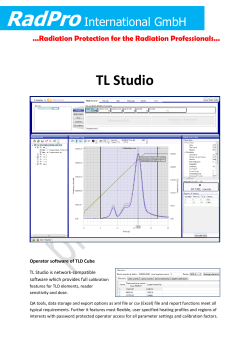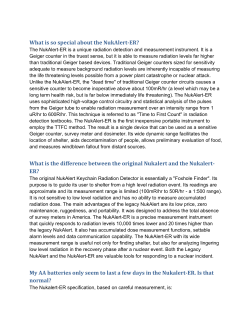
MIRDcell [Java]. Version 1.0: Web-based Dose Response Modeling Interface for Radiation Research
MIRDcell [Java]. Version 1.0: Web-based Dose Response Modeling Interface for Radiation Research Wu, Han Dr. Roger W. Howell’ Lab New Jersey Medical School, UMDNJ Outline • • Introduction Methodology • Cellular and Multi-cellular Dosimetry • Web-Based Computation Tools • • • Results and Performance Evaluation Conclusion Future Work Introduction In the field of radiation research, one most important application in ionizing radiation is for radiation therapy. • Electrons • X-rays • Gamma rays are used in radiation therapy to treat malignant tumors. It is important to monitor the radioactivity within the tissues or cells by obtaining the cellular dose values so that during the next stage we could get the information including the corresponding effects or response. 3 Given a spherical cluster of cells where the cells are labeled with any type of radionuclide, people would like to see the values of the self-dose and cross-dose, and the response to the customized changes or settings in the forms of value or graphical display. Figure. Courtesy to Roger W. Howell 4 • What happens when cells have different amounts of activity in them? • What occurs when the geometry of the cells changes? • What if the radionuclide is changed? 5 A web-based plug-in in form of jApplet that it could be easily embedded into the website to be accessed from the Web browser, hence, it is much more convenient for the users to do the accurate calculations of Self-dose and Multi-cellular dosimetry on any platforms and to see the fast response to their interactive changes. 6 Methodology • Cellular and Multi-cellular Dosimetry What is the algorithm? • Web-Based computation Tools What is the developing environment? What is the procedures? 7 Cellular and Multi-cellular Dosimetry Algorithm for Calculation of Self-dose and Cross-dose Figure 1. Geometry for cross-dose calculations in multicellular clusters The cellular dose values (selfdose) and the multi-cellular (cross-dose) dose values were calculated with monoenergetic electron or alpha particle, and other radionuclides (Auger, beta and alpha emitters) sources distributed uniformly in different cell compartments (cell surface, cytoplasm, and nucleus). 8 Web-Based Computation Tools Developing Environment • Sun’s Netbeans IDE 6.5, a widely used Java IDE tool. • AWT (Abstract Windowing Toolkit ) • SWING using Java 2D™ API is proposed. 9 Figure 2. Netbeans IDE 6.5 Figure 3. Windows and panels in Netbeans IDE 6.5 Web-Based Computation Tools Application server implemented: Figure 4. web application server 12 Web-Based Computation Tools The core part of the coding for computation is written by Dr. Howell. The purpose of translating the original Fortran code to Java code is for the use in the next step, for example, the interactive calculation of radiation dosimetry of multi-cell, with further developed Java interface or Java Applet, this program could be improved to be Web-based executive program or it could be easily embedded into the website The functionalities provided for other researchers are shown in figure 5 – figure 9. 13 Figure 5. Display panel for animation 14 Figure 6. Control panel for with selection list 15 Figure 7. Control panel for parameter selection, action for computing, result retrieving. 16 Figure 8. Control panel for source radiation selection, self-defined parameter input. 17 Figure 9. Display area Left: for showing input datasheet Right: for showing output 18 The Java application package is built into jApplet, then a web application is created in Netbeans IDE in order to bundle the web application with GlassFish V3 web application server. Now this jApplet is running successfully on the local hosting. By importing the jApplet into the JSP source code and uploading all the web pages onto web space in the Cluster of High Performance Computing in UMDNJ, this userbased interface will be available within the all Internet. 19 Results and Performance Evaluation This successfully designed GUI has the functions that are including: • Choose input files for different radionuclides and being able to return the output; • Creating monoenergetic particles, new radionuclides; • Change the radius of source cell or target cell; • Adjust the distance between source and target, the interactive display for self-dose and cross-dose models. 20 Figure 10. Homepage for login Figure 11. Page for Graphical User Interface Results and Performance Evaluation Firstly it will be able to see the two selection lists for input datasheet and five source - target combinations Figure. Control panel for with selection list 23 Results and Performance Evaluation Secondly we could choose three different applications based on three source radiation mode including: • • • Predefined Radionuclide Monoenergetic Electron or Alpha particle User Created Radionuclide 24 Results and Performance Evaluation Thirdly, we also have another very important panel from which we could set the radius of the cell and nucleus as well as the distance by using the corresponding input field or button. Figure. Control panel for parameter selection, action for computing, result retrieving. 25 Results and Performance Evaluation Finally, based on our selections and setting done in the functions panel, we could use the two executing buttons to carry out the computations and get corresponding dose values. Furthermore, all of these settings and changes could be interactively displayed in the Display panels including the Input area, Output area, Canvas panel developed by Java 2D API. 26 Figure 12. Log out, or sign in again Conclusion The first objective of this project is to finish interactive calculation, modeling and display of cellular dose values; The second is to implement a Java Applet embedded into the website; The third is to bring large distributed modeling and simulations to the users’ desktop by providing webbased portals for interaction and control. All these three objectives have been achieved as shown in the selected figures. 28 Future Work 2D modeling and display for self-dose and cross-dose, the biological response of the cell clusters in one layer should be continued. Figure. 2-D cell cluster in one layer 29 We also want to see: • What happens to the response when the percentage of labeled cells changes? • What happens when cells have different amounts of activity in them? • What occurs when the geometry of the cluster changes? • Where are the cells that are Figure 13. Dose-response modeling for 200 µm diameter cluster wherein 10% of the cells are labeled with 131IdU. Courtesy to Roger W. Howell responsible for the saturation in dose response curves? • What if the radionuclide is changed? a (a) The unlabelled cells in the mosaic spheroid. There are 529 cells in this arrangement. Courtesy to Charlton DE b (b) The complete mosaic spheroid with a total of 2459 cells. Reference [1] S. Murty Goddu, Dandamudi V. Rao and Roger W. Howell, Multicellular Dosimetry for Micrometastases: Dependence of Self-Dose Versus Cross-Dose to Cell Nuclei on Type and Energy of Radiation and Subcellular Distribution of Radionuclides, The Journal of Nuclear Medicine Vol. 35 No. 3 521-530, 1994. [2] J. A. Siegel, S. R. Thomas, J. B. Stubbs, M. G. Stabin, M. T. Hays, K. F. Koral, J. S. Roberston, R. W. Howell , B. W. Wessels, D. R. Fisher, D. A. Weber, and A. B. Brill, MIRD Pamphlet No. 16: Techniques for quantitative radiopharmaceutical biodistribution data acquisition and analysis for use in human radiation dose estimates. J. Nucl. Med. 40: 2, 37S-61S, 1999. [3] W. E. Bolch, L. G. Bouchet, J. S. Robertson, B. W. Wessels, J. A. Siegel, R. W. Howell , A. K. Erdi, B. Aydogan, S. Costes, and E. E. Watson, MIRD Pamphlet No. 17: The dosimetry of nonuniform activity distributions - radionuclide S values at the voxel level. J. Nucl. Med. 40: 1, 11S-36S, 1999. [4] International Commission on Radiation Units and Measurements. Absorbed Dose Specification in Nuclear Medicine. Report Committee: SJ Adelstein, Chair, AJ Green, RW Howell , JL Humm, PK Leichner, JA O'Donoghue, SE Strand, BW Wessels. Journal of the ICRU 2: 1 1-110, 2002. [5] P. V. S. V. Neti and R. W. Howell, When may a nonuniform distribution of I131 be considered uniform? An experimental basis for multicellular dosimetry, The Journal of Nuclear Medicine Vol. 44, 2019-2026, 2003. [6] P. V. S. V. Neti and R. W. Howell, Log Normal Distribution of Cellular Uptake of Radioactivity: Implications for Biologic Responses to Radiopharmaceuticals, The Journal of Nuclear Medicine Vol.47 No.6, 2006. [7] NetBeans IDE 5.5, http://netbeans.org, Retrieved on 2009-03-05. [8] Kaplan I. Nuclear Physics. Reading: Addison-Wesley; 1963 [9] Java 2D™ API, http://java.sun.com/docs/books/tutorial/2d/index.html, Retrieved on 2008-08-08. [10] Patrick Niemeyer, Jonathan Knudsen. O'Reilly's Learning Java, Second Edition, 2007 [11] W. R. Gilks, P. Wild (1992), Adaptive Rejection Sampling for Gibbs Sampling, Applied Statistics, Vol. 41, Issue 2, 337-348. [12] Gilks, Richardson and Spiegelhalter, Markov Chain Monte Carlo in Practice Interdisciplinary Statistics, 1996 [13] OLINDA/EXM: The Second-Generation Personal Computer Software for Internal Dose Assessment in Nuclear Medicine [14] http://www.doseinfo-radar.com/RADARSoft.html, Retrieved on 2009-07-27. [15] MIRD Pamphlet No. 14, Revised (Thomas et al. 1999), Retrieved on 2009-07-27 [16] Web based distributed computing environment for nanotechnology, Chen, D., Raghunathan, A., Mashl, J., Chiu, S., Parker, S., Aluru, N., Jakobsson, E. , 2005 NSTI Nanotechnology Conference and Trade Show - NSTI Nanotech 2005 Technical Proceedings, pp. 720-723 [17] Sastiy KSR, Haydock C, Basha AM, Rao DV. Electron dosimetry for radioimmunotherapy: optimal electron energy. Radiat Prot Dosim 1985; 13:249-252. [18] R. W. Howell, D. V. Rao, Haydock C. Dosimetry techniques for thearapeutic applications of incorporated radionucides. In: Adeistein SJ, Kassis Al, Burt RW,eds. Dosimetry of administered radionuclides. Washington, DC: American College of Nuclear Physicians;1990:215-256. [19] Cole A. Absorption of 20eV to 50,000eV electron beams in air and plastic, Radiat Res 1969;38:7-33 [20] Loevinger R, Budinger TF, Watson EE. MlRD primer for absorbed dose calculations, revised. New York: The Society of Nuclear Medicine; 1991. [21] S. M. Goddu, R. W. Howell, and D. V. Rao, Cellular dosimetry: Absorbed fractions for monoenergetic electron and alpha particle sources and S-values for radionuclides uniformly distributed in different cell compartments. J. Nucl. Med. 1993; 35: 303-316. [22] Berger MJ.Beta-ray Dosimetry calculation with the use of point kernels. In: Cloutier RJ, Edwards CL, Snyder WS, eds. Radiation dose and effects, Washington,DC: U.S. Atomic Energy Commission;1970:63-86. [23] Write once, run anywhere, Computer Weekly. 2002-05-02. Retrieved on 2009-07-27. [24] JavaSoft ships Java 1.0, Sun Microsystems. 1996-01-23. Retrieved on 2008-08-03. "Java's write-once-run-everywhere capability along with its easy accessibility have propelled the software and Internet communities to embrace it as the de facto standard for writing applications for complex networks" [25] B. Plale, G. Eisenhauer, K. Schwan, J. Heiner, V. Martin, and J. Vetter. “From Interactive Applications to Distributed Laboratories,” IEEE Concurrency, IEEE Computer Society Press, pp. 78 - 90. April-June 1998. [26] Charlton DE, Radiation effects in spheroids of cells exposed to alpha emitters, Int J Radiat Biol. 2000 Nov;76(11):1555-64. Thank you ! Questions? Q: Do you like Dr. Howell: What ? Go ?
© Copyright 2025


















